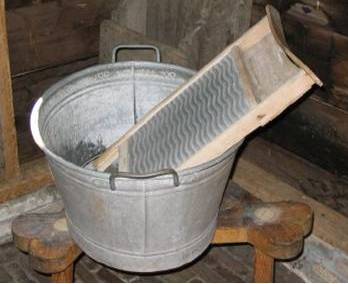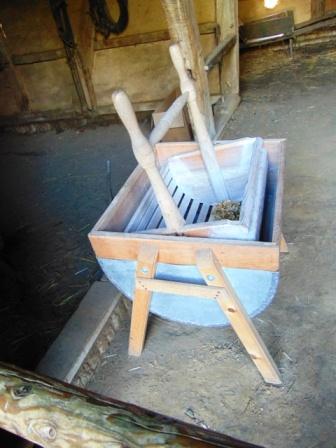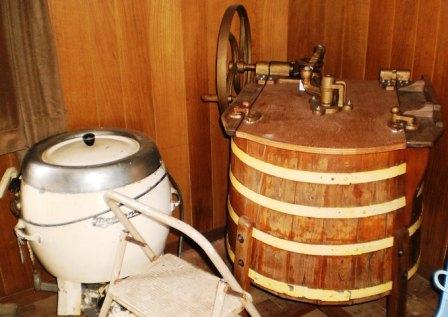Fabric is made from fibers of plants, animal hair, or chemical stuff.
So it varies from natural, vegetable or animal, on artificial made from natural raw materials, to fully synthetic fibers.
Dirt and stains can be equally diverse. It may be organic dirt and grease (oil, skin grease..)
protein (blood, leftovers..), acids (fruit, sweat..), starch (wheat, sauces..), salts, sugar.. or inorganic dirt like metal or rust, dust, pen...
 The combination of all these types of fabric with all kinds of dirt actually requires as many different treatments to remove the dirt. We restrict ourselves to general rules, with the same principles as when cleaning.
The combination of all these types of fabric with all kinds of dirt actually requires as many different treatments to remove the dirt. We restrict ourselves to general rules, with the same principles as when cleaning.
What can, you should (first) clean dry: beating, brushing, yucky.
Then washing with water and soap follows. (And possibly chemical cleaning with solvents.)
Wear your clothes (including underwear) with confidence at least 2 consecutive days. This saves a considerable number of washes per year, good for clothing, environment and your wallet. Do you have wool worn a day? Just let it ventilate some time.
If you only wash after you 've worn something three times you will save 66% on detergent, energy and water. And the clothes wear out less.
Dried stains are stubborn. So remove them fresh, as soon as possible.
As with cleaning also for washing fabrics same five factors do influence:
• temperature: hotter washes better, soaks more dirt, and soluble more soap.
• duration: short laundry is less efficient, hard dirt you let soak first, or you give it a prewash. Dirty collars and stains can be rubbed a half to three hours in advance with soapy water. Previously, the wash was put in the sink on Sunday. Throughout Monday were the women busy scrubbing, bleaching, rinsing and scouring.
• abrasive: the wash drum, or a ribbed washboard (also used as a musical instrument). Or by hand, fabric sanding over itself.
• the mechanical movement: turning, stirring, squeezing, rubbing.
• the product, the soap. And hard or soft (rain) water.
 Sort the laundry according to care symbols (type of fabric, composition).
Sort the laundry according to care symbols (type of fabric, composition).
Sort by type of fabric: delicate fabrics (silk, synthetics) separated from heavier fabrics (such as linen).
Sort by color: dark -colored, light-colored and white laundry.
Separate heavily soiled laundry and less dirty laundry.
Wash new clothes separately the first few times. The color may still release. This can also with substance that is not colorfast. Test it by putting on a not eye-catching part of kitchen paper on the damp fabric and go press on it with a hot iron.
Put the washer full, not to waste water and energy. Was on nightly rate.
Do not overfill the drum. You then have too little water in relation to the laundry. Crammed together the clothes get then too little room to move, and dirt to rinse out.
Do not use prewashing program if fabric was not really dirty. Just a short program for coloreds. Use half of the soap powder, which is usually sufficient.
Wool you never wash too hot nor squeeze, or you get felt.
Turn all the pockets inside out and empty them.
Turn garments inside out, especially pants (otherwise you might get pale stripes) and sweaters and shirts with print.
Make sure you can never falter, hook and tear laundry. Close all zippers, snaps and hooks and tie strings together.
The best fabric softener is a dash of vinegar. This also ensures that your laundry retains its color.
 Remove the laundry when it is ready right out of the machine. If it stays wet for too long it is going moldy and smelly. So do not hang up or fold and stack before it is completely dry.
Remove the laundry when it is ready right out of the machine. If it stays wet for too long it is going moldy and smelly. So do not hang up or fold and stack before it is completely dry.
Pants you hang best with the pipes. The weight pulls the creases out.
Colored fabrics may fade in sunlight.
White goods were turned on in the sun down on the grass to whiten.
Beer without alcohol is like a bra on the clothesline, the best gone.
Washboards were before they were used as zinc plate available in wood. In a thick, wide plank grooves were cut or gouged and sanded. (In the open air museum of Bokrijk are still several showed.)
Various non-electric washers
http://www.greenevelien.com/1Eco_15schoonmaken.php#wassenzonderelektra
